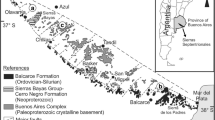Abstract
In this study, the suitability of the threshold alkali level, TAL, the kinetic parameter, In k, and the microstructural disorder coefficient, Cd, of the aggregates, taken as alkali-silica reactivity criteria, was assessed using different typologies of Italian natural ASR-susceptible aggregates of known field performance. The TAL, In k, and Cd were determined using a modified version of the RILEM AAR-3 concrete prism expansion test, the ASTM C1260 mortar-bar expansion test, and the infrared spectroscopy test, respectively. It was found that the three reactivity criteria are all appropriate for discriminating between reactive and innocuous aggregates. However, the TAL proves to be a more suitable criterion for interpreting the field performance data of the aggregates investigated. There exists a linear relationship between TAL and In k, or between TAL and Cd, which provides a rapid means of estimating the threshold alkali levels of ASR-susceptible aggregates from the results of the ultra-accelerated mortar-bar test and/or the infrared spectroscopy test. A TAL-based classification of the degree of reactivity of the aggregates, as well as some modifications of the reactivity domains established by the infrared spectroscopy method are also proposed.
Résumé
Dans cette étude on a vérifié la fiabilité du Niveau de Seuil des Alcalis, NSA, du paramètre cinétique, In k, et du coefficient de désordre microstructurel, Cd, comme critères de réactivité alcalis-silice (A-S), en utilisant de différentes typologies de granulats naturels d'origine italienne susceptibles de manifester cette réactivité et dont le comportement en service à long terme était bien connu. Les paramètres de réactivité NSA, In k et Cd ont été déterminés respectivement au moyen de l'essai d'expansion sur des éprouvettes de béton RILEM AAR-3 dûment modifié, de l'essai d'expansion sur des éprouvettes de mortier ASTM C1260 et de l'essai de spectrographie infrarouge. Les résultats montrent que tous les trois critères sont bien appropriés pour distinguer les granulats réactifs de ces non réactifs. Toutefois, le paramètre NSA se révèle le plus approprié pour évaluer les donnés de comportement en service des granulats examinés. Il existe une relation linéaire entre NSA et In k, ou entre NSA et Cd, en mesure de fournir un moyen rapide pour estimer le Niveau de Seuil des Alcalis des granulats susceptibles de réaction A-S à partir des résultats de l'essai ultra-accéléré sur des éprouvettes de mortier et/ou de la spectrographie infrarouge. On a aussi proposé un classement du niveau de réactivité des granulats basé sur le paramètre NSA et un changement des critères de réactivité établis par la méthode de spectrographie infrarouge.
Similar content being viewed by others
References
CSA A23.2-27A, ‘Standard Practice to Identify Degree of Alkali-Reactivity of Aggregates and to Identify Measures to Avoid Deleterious Expansion in Concrete’ (Canadian Standards Association, Rexdale, 2000) 260–269.
CSA A23.2-14A, ‘Potential Expansivity of Aggregates (Procedure for Length Change Due to AAR in Concrete Prisms)’ (Canadian Standards Association, Rexdale, 1994) 205–214.
ASTM C1293-01, ‘Standard Test Method for Determination of Length Change of Concrete Due to Alkali-Silica Reaction’ (American Society for Testing and Materials, West Conshohocken, 2003) CD-ROM, pp. 6.
RILEM Recommended Test Method AAR-3 (formerly B-TC 106-3), ‘Detection of Potential Alkali-Reactivity of Aggregates —Method for Aggregate Combinations using Concrete Prisms’,Mater. Struct. 33 (229) (2000) 290–293.
CSA A23.2-25A, ‘Test Method for Detection of Alkali-Silica Reactive Aggregate by Accelerated Expansion of Mortar Bars’ (Canadian Standards Association, Rexdale, 1994) 236–242.
ASTM C1260-01, ‘Standard Test Method for Potential Alkali Reactivity of Aggregates (Mortar-Bar Method)’ (American Society for Testing and Materials, West Conshohocken, 2003) CD-ROM, pp. 5.
RILEM Recommended Test Method AAR-2 (formerly A-TC 106-2), ‘Detection of Potential Alkali Reactivity of Aggregates—The Ultra-Accelerated Mortar-Bar Test’,Mater. Struct. 33 (229) (2000) 283–289.
Berra, M., Mangialardi, T. and Paolini, A.E., ‘A new approach for assessing the potential alkali-expansivity of slowly reactive siliceous aggregates’,Adv. Cem. Res. 11 (3) (1999) 139–147.
Johnston, D. and Fournier, B., ‘A kinetic-based method for interpreting accelerated mortar bar test (ASTM C1260) data’, in ‘Alkali-Aggregate Reaction’, Proceedings of the 11th International Conference, Québec, Canada, 2000 (Centre de Recherche Interuniversitaire sur le Béton (CRIB), Laval and Sherbrooke Universities, 2000) 355–364.
Berra, M., Mangialardi, T. and Paolini, A.E., ‘Rapid evaluation of the threshold alkali level for alkali-reactive siliceous aggregates in concrete’,Cem. Concr. Composites 21 (1999) 325–333.
Berra, M., Mangialardi, T. and Paolini, A.E., ‘Une nouvelle méthodologie de qualification des granulats siliceux vis-à-vis de l'alcali-réaction dans le béton’,Mater. Struct. 36 (259) (2003) 302–310.
British Cement Association, ‘Testing Protocol for Greywacke Aggregates-BSI/517/1/20 ad hoc Group on ASR’ (BCA, Crowthorne, Berkshire, 1999) 1–8.
Bachiorrini, A., ‘A method to test the alkali reactivity of siliceous aggregates: infrared spectroscopy’, in ‘Concrete Durability’, Proceedings of the K. and B. Mather International Conference, Atlanta, USA, 1987 (ACI-SP 100, American Concrete Institute, Detroit, 1987) 1821–1832.
Bachiorrini, A., Baronio, G., Berra, M., Delmastro, A., Montanaro, L. and Negro, A., ‘Infrared spectroscopy in the evaluation of aggregates in ASR deteriorate concretes from many parts of the world: comparison with other methods’, in ‘Concrete Alkali-Aggregate Reaction’, Proceedings of the 7th International Conference, Ottawa, Canada, 1986 (Noyes Publications, New Jersey, 1987) 309–313.
RILEM Recommended Test Method AAR-1, ‘Detection of Potential Alkali-Reactivity of Aggregates—Petrographic Method’,Mater. Struct. 36 (261) (2003) 480–496.
RILEM TC191-ARP, ‘RILEM Recommended Test Method AAR-0: Detection of Alkali-Reactivity Potential in Concrete—Outline Guide to the Use of RILEM Methods in Assessments of Aggregates for Potential Alkali-Reactivity’,Mater. Struct. 36 (261) (2003) 472–479.
Hooton, R.D. and Rogers, C.A., ‘Development of the NBRI rapid mortar bar test leading to its use in North America’, in ‘Alkali-Aggregate Reaction in Concrete’, Proceedings of the 9th International Conference, London, UK, 1992 (The Concrete Society, Wexham, 1992) 461–467.
Moore, A.E., ‘Effect of electric current on alkali-silica reaction’, in ‘Effects of Alkalies in Cement and Concrete’, Proceedings of the 4th International Conference, West Lafayette, USA, 1978 (School of Civil Engineering, Purdue University, West Lafayette, 1978) 69–72.
Nixon, P.J., Collins, R.J. and Rayment, P.L., ‘The concentration of alkalies by moisture migration in concrete-A factor influencing alkali-aggregate reaction’,Cem. Concr. Res. 9 (4) (1979) 417–423.
Natesaiyer, K. and Hover, K.C., ‘Investigation of electrical effects on alkali-aggregate reaction’, in ‘Concrete Alkali-Aggregate Reaction’, Proceedings of the 7th International Conference, Ottawa, Canada, 1986 (Noyes Publications, New Jersey, 1987) 466–471.
Xu, Z. and Hooton, R.D., ‘Migration of alkali ions in mortar due to several mechanisms’,Cem. Concr. Res. 23 (4) (1993) 951–961.
Berra, M., Mangialardi, T., Paolini, A.E. and Turriziani, R., ‘Critical evaluation of accelerated test methods for detecting the alkali-reactivity of aggregates’,Adv. Cem. Res. 4 (1) (1991/92) 29–37.
Author information
Authors and Affiliations
Additional information
Editorial Note Università degli Studi di Roma “La Sapienza” (Italy) is a RILEM Titular Member. Mr. Mario Berra is a RILEM Senior Member. He participates in the work of RILEM TC 191-ARP ‘Alkali-reactivity and prevention-Assessment, specification and diagnosis of alkali-reactivity’.
Rights and permissions
About this article
Cite this article
Berra, M., Mangialardi, T. & Paolini, A.E. Alkali-silica reactivity criteria for concrete aggregates. Mat. Struct. 38, 373–380 (2005). https://doi.org/10.1007/BF02479304
Received:
Accepted:
Issue Date:
DOI: https://doi.org/10.1007/BF02479304




